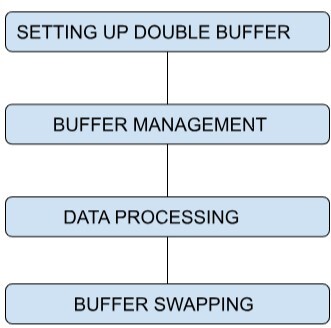
 Data Structure
Data Structure Networking
Networking RDBMS
RDBMS Operating System
Operating System Java
Java MS Excel
MS Excel iOS
iOS HTML
HTML CSS
CSS Android
Android Python
Python C Programming
C Programming C++
C++ C#
C# MongoDB
MongoDB MySQL
MySQL Javascript
Javascript PHP
PHP
- Selected Reading
- UPSC IAS Exams Notes
- Developer's Best Practices
- Questions and Answers
- Effective Resume Writing
- HR Interview Questions
- Computer Glossary
- Who is Who
Double Buffering
Double buffering is essential for improving user experience and performance. This method is extensively used to reduce delays, increase performance, and enable smooth multitasking in database management systems, streaming media applications, and graphics rendering.
In order to optimise data transit and processing, double buffering is used which is a programming approach that uses two buffers or temporary storage spaces. It enables the execution of input and output processes simultaneously, thereby minimising delays and enhancing system performance as a whole. Double buffering allows for efficient multitasking and effective resource management by using one buffer for data storage while the other is in use.
Double Buffering in Database Management Systems
Double buffering is used in database management systems to enhance data processing and transmission. Two buffers are put into use, one of which is actively used for input and output activities while the second buffer gathers data for processing. The buffers are switched when processing is finished which enables smooth data flow and reduces wait times.
Implementing Double Buffering

Setting up Double Buffers
Allocating memory for the buffers and establishing the required data structures are the initial steps in setting up double buffers. In order to do this, two buffers must be created and initialised suitably in accordance with the needs of the programme.
Buffer Management
A buffer manager is in charge of assigning space in the buffers for data storage after they have been set up. The buffer manager controls internal tasks and makes sure the buffers are used effectively.
Data Processing
Concurrent processing of data is possible because of buffers. It is possible to write to one buffer while reading from another, enabling smooth multitasking and better performance.
Buffer Swapping
The buffers are switched when data processing is finished, ensuring a smooth transition between the old and new data sets. Usually, the programming environment's callbacks or specific functions are used to carry out this switching operation.
Benefits of Double Buffering
Minimising Delays
Data transfer and processing are made more efficient thanks to double buffering, which shortens the time between input and output activities. This is especially crucial in real?time applications like gaming and multimedia, where user experience can be significantly impacted by delays.
Improved Performance
Double buffering improves a system's overall performance by enabling many processes to operate concurrently. It allows for multitasking and effective resource management, which leads to quicker execution and better responsiveness.
Preventing Bottlenecks
Bottlenecks are caused when an excessive volume of data overpowers a system, causing delays or unresponsiveness. Double buffering helps avoid these bottlenecks. Double buffering maintains a constant flow of information and eliminates performance deterioration by dividing data over several buffers.
Enhanced Visuals and Animations
Double buffering is frequently used in graphics rendering to provide smooth and authentic animations. Double buffering avoids flickering and enhances the visual experience in applications like games and multimedia by displaying one frame while buffering the next.
Conclusion
This article consists of double buffering, which is used to improve performance and make the system multitasking. Double buffer in dbms is used to improve data processing and trasmissions. To implement double buffer, step that are used are setting up double buffer, buffer management, data processing and buffer swapping. Advantages of double buffer are minimising delays, improved performance, preventing bottlenecks and enhanced visuals and animations.

